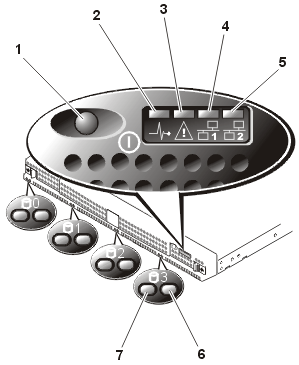Dell™ PowerVault™ 715N Systems Service Manual
| Overview | System Beep Codes | ||
| System Messages | Status Indicators |
This section describes beep codes, system error messages, and system status indicators that can occur during system startup or, in the case of some failures, during normal system operation. The tables in this section list faults that can cause a beep code or system error message to occur and the probable causes of the fault in each case. This section also suggests actions you can take to resolve problems indicated by a message.
If a faulty system does not emit beep codes or display system error messages to indicate a failure, run the appropriate tests in the system diagnostics to help isolate the source of the problem. See "Running System Diagnostics."
Several different types of messages can indicate when the system functions improperly:
System messages alert you to a possible operating system problem or a conflict between the software and hardware.
To view system messages, perform the following steps:
Table 1 lists the system error messages and the probable cause for each message.
 |
NOTE: If you receive a system message that is not listed in Table 1, check the documentation for the application program that is running when the message appears or the operating system documentation for an explanation of the message and recommended action. |
| Message | Cause | Corrective Action |
|---|---|---|
| HDD Controller Failure | BIOS cannot communicate with the hard-drive controller. | Check the connections to the hard drive. Reinstall the hard drive. Check the interface cable and power cable connections to the backplane board. If the problem persists, replace the system and midplane board. |
| CMOS Battery Low | The battery on the system board is low. | Replace the system battery. If the problem persists, replace the system and midplane board. |
| CMOS Checksum Bad | The checksum value (CMOS RAM settings) differs from the current value. | In the BIOS Setup utility, select to autoload the optimal setting. See "Using the BIOS Setup Utility" for information about changing this setting. |
| CMOS Time and Date Not Set | The BIOS does not have date and time values. | Use the BIOS Setup utility to set the time and date. See "Using the BIOS Setup Utility" for information about changing this setting. |
| Pri Master HDD error | Primary hard drive is not responding. | Replace the primary hard drive. If the problem persists, replace the system and midplane board. |
| Sec Master HDD error | Secondary hard drive is not responding. | Replace the secondary hard drive. If the problem persists, replace the system and midplane board. |
| Cache Memory Error | Cache memory is defective. | Disable the cache memory in the BIOS Setup utility. See "Using the BIOS Setup Utility." |
When an error that cannot be reported (through a console redirection screen) occurs during a boot routine, the system may emit a series of beeps that identify the problem. The beep code is a pattern of sounds; for example, five beeps indicate a problem with the microprocessor. This information is valuable to the technical support representative if you need to call for technical assistance.
When a beep code is emitted, record it, and then look it up in Table 2. If you are unable to resolve the problem by looking up the meaning of the beep code, use the system diagnostics to identify a more serious cause. See "Running System Diagnostics."
Table 2. System Beep Codes
| Code | Cause | Corrective Action |
|---|---|---|
| 1 | The memory refresh circuitry on the system board is faulty. | Replace the system and midplane board. |
| 2 |
Base 64 KB memory failure. | Switch memory modules. Remove and reseat the memory modules. If the problem persists, replace the memory modules. If the problem still persists, replace the system and midplane board. |
| 5 7 |
Microprocessor error. Microprocessor exception interrupt error. |
Remove and reseat the microprocessor. If the problem persists, replace the microprocessor. If the problem still persists, replace the system and midplane board. |
| 10 | ROM checksum error. | The ROM checksum value does not match the value encoded in the BIOS. Replace the system board battery. If the problem persists, replace the system and midplane board. |
Figure 1 shows the indicators on the system's bezel.
 |
|
Each hard drive has two LED indicators, an operation LED on the left side and an activity LED on the right side. LEDs are visible when the bezel is attached to the front of the system. The LEDs provide the following information for each drive: